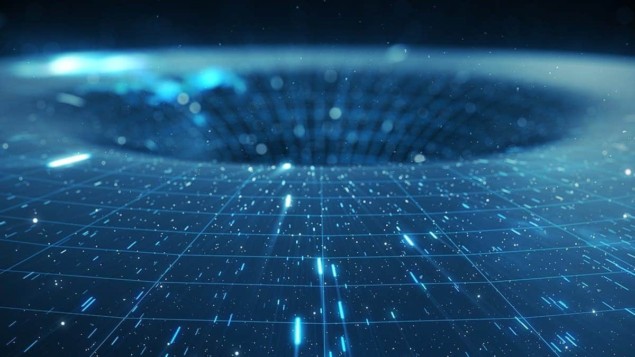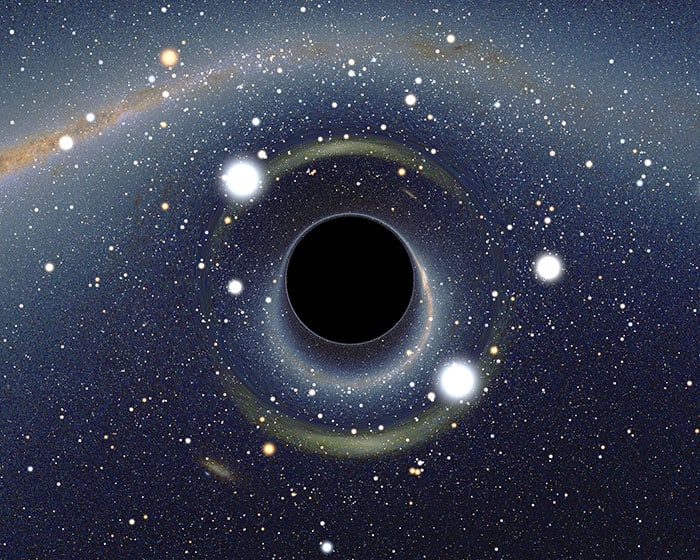
Since they were first observed in 2015, gravitational waves have enabled scientists to detect large numbers of previously unseen black holes and work out some of the objects’ bulk properties – such as their masses and distances from Earth. But a pair of physicists in the UK reckons it should be possible to do much better. The researchers argue in a new paper that gravitational waves could tell us in some detail about how black holes swallow up objects as they grow – and in doing so help resolve the information paradox brought about by Hawking radiation.
Black holes are famous for devouring any object that crosses their event horizons. At the same time, they are thought to continuously leak energy to space in the form of Hawking radiation. Proposed by Stephen Hawking in 1974, this emission is black-body radiation that causes a black hole to shrink and eventually disappear. The only non-random feature about these leaking photons is their energy, which is determined by the black hole’s mass. This emission leads to a paradox – that the black hole will lose all the information it once contained about the objects it captured, contradicting the non-destruction of information as stipulated by quantum mechanics.
Physicists have put forward numerous possible solutions to this puzzle, most involving some subtle encoding of information within Hawking radiation. But Louis Hamaide and Theo Torres of King’s College London reckon that gravitational waves can offer a more natural way out. They have found that almost all of the information about any object sucked into a black hole would be retrievable by measuring the gravitational radiation given off as that object disappears into oblivion.
So far, gravitational waves from black holes have been detected by the LIGO–Virgo observatories. This are kilometre-sized laser interferometers that detect signals that are emitted by pairs of black holes as they spiral in on one another and then coalesce. These black holes are so massive that their gravitational radiation is strong enough to remain detectable after propagating millions of light–years to Earth.
Infalling object
In their new research, Hamaide and Torres instead consider the radiation given off by very small objects falling into Schwarzschild black holes – these are black holes that do not spin and have no electrical charge. The duo’s calculations exploit perturbation theory, which is essentially a correction of a black hole’s properties by the infalling object. This approach yields an exact, analytical expression for the emitted radiation – in contrast to the numerical simulations and curve fitting needed to work out the behaviour of two bodies with similar masses.
Working through the equations, the researchers found that the signature left by an in-falling object is surprisingly simple. While the mass of the black hole is tied to the frequency of the gravitational waves, the mass of the captured object is instead encoded in the waves’ amplitude. The timing of the capture is revealed by the radiation’s phase, while its trajectory can be worked out by observing the emission from multiple vantage points.
Hamaide maintains that these data would be much easier to collect and interpret than the “very spread out” information perhaps obtainable from Hawking radiation. “We are seeing that the information comes in very nice packets,” he adds.
However, other researchers are sceptical about the utility of these gravitational-wave signatures. Robert Mann of the University of Waterloo in Canada argues that what matters is not information about objects falling into a black hole once it has formed but instead knowledge of what created the black hole in the first place. He also says that the authors make a valid point about a black hole being “basically an open quantum system”, but notes that they carry out very little quantum or even semi-classical analysis.
Quantum deficit
Hamaide and Torres acknowledge that the signatures are entirely classical while the object’s complete description would be quantum-mechanical – coming in the form of its wavefunction. They calculate that the classical information would account for well over 99.9% of the total, but point out that only 100% will do when it comes to completely resolving the information paradox. In other words, they say, no matter how accurate the measurements are their analysis will never recover all of the information from a black hole.
In fact, Vitor Cardoso of the University of Lisbon in Portugal and the Niels Bohr Institute in Copenhagen argues that it would not be possible to measure the classical information in all cases – given that matter collapsing with complete spherical symmetry would not generate gravitational waves. Cardoso also doubts that any practical measurements could be made – given what he says would be the need for multiple, infinitely sensitive detectors surrounding the source.

Physicists stimulate Hawking radiation from optical analogue of a black hole
Jorge Pullin of Louisiana State University in the US is also sceptical about the latest work’s practical utility, while praising the authors’ “interesting points about information retrieval”. He notes that current observations of gravitational waves struggle to resolve the colliding objects’ mass and spin (including the latter’s sign). “This is not likely to change too much in the near future,” he adds.
Hamaide acknowledges that the tiny signals from the pertubative system they have considered could not be picked up by any existing or planned detector. Still, he argues that there is one aspect of their work that ought to offer comfort to today’s astrophysicists. This is the fact that it rules out the theoretical possibility (known as degeneracy) that as gravitational wave detectors become more sensitive it will become more (not less) difficult to home in on specific values for black hole masses and other properties. “That won’t happen,” he says.
The research is described in Classical and Quantum Gravity.



